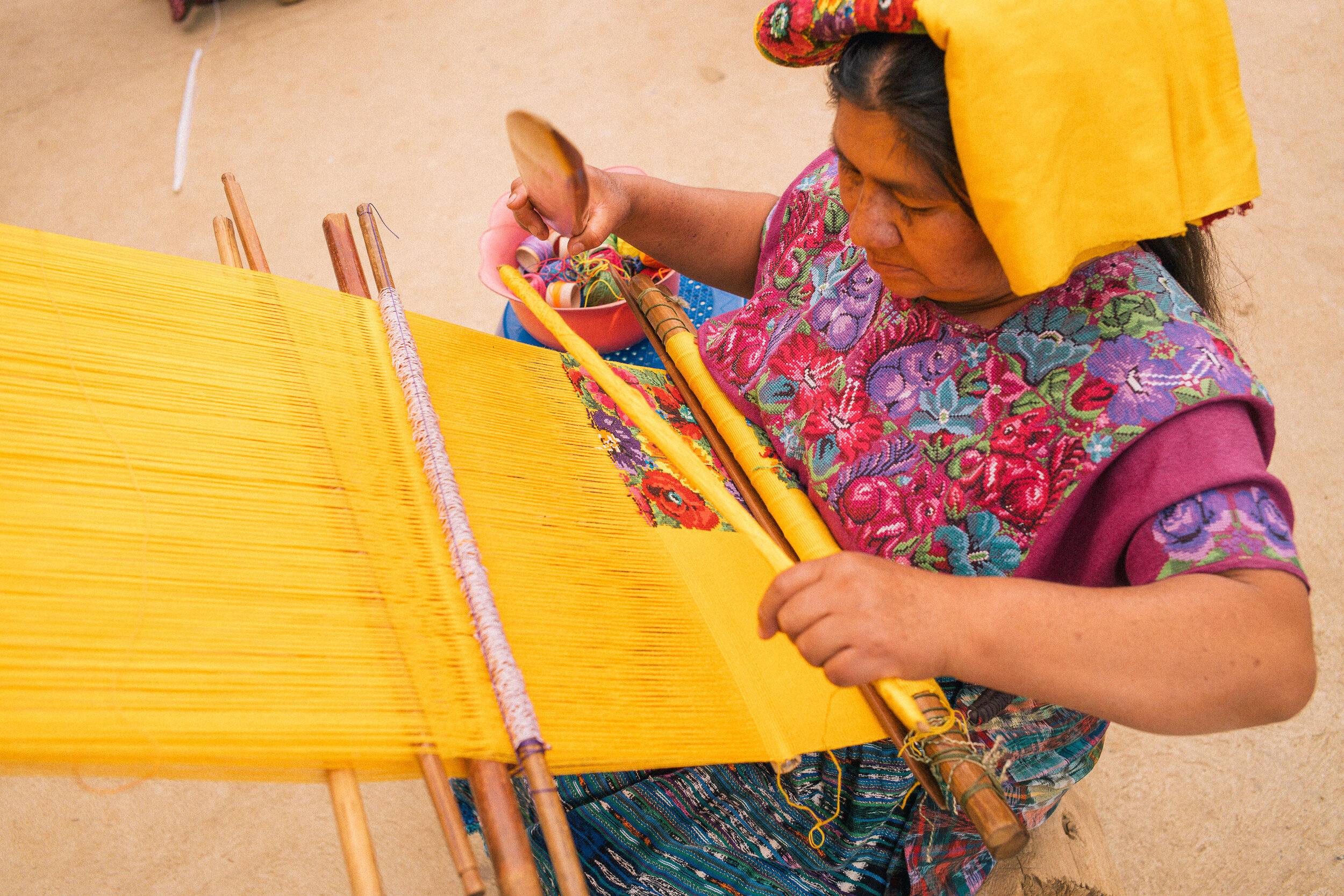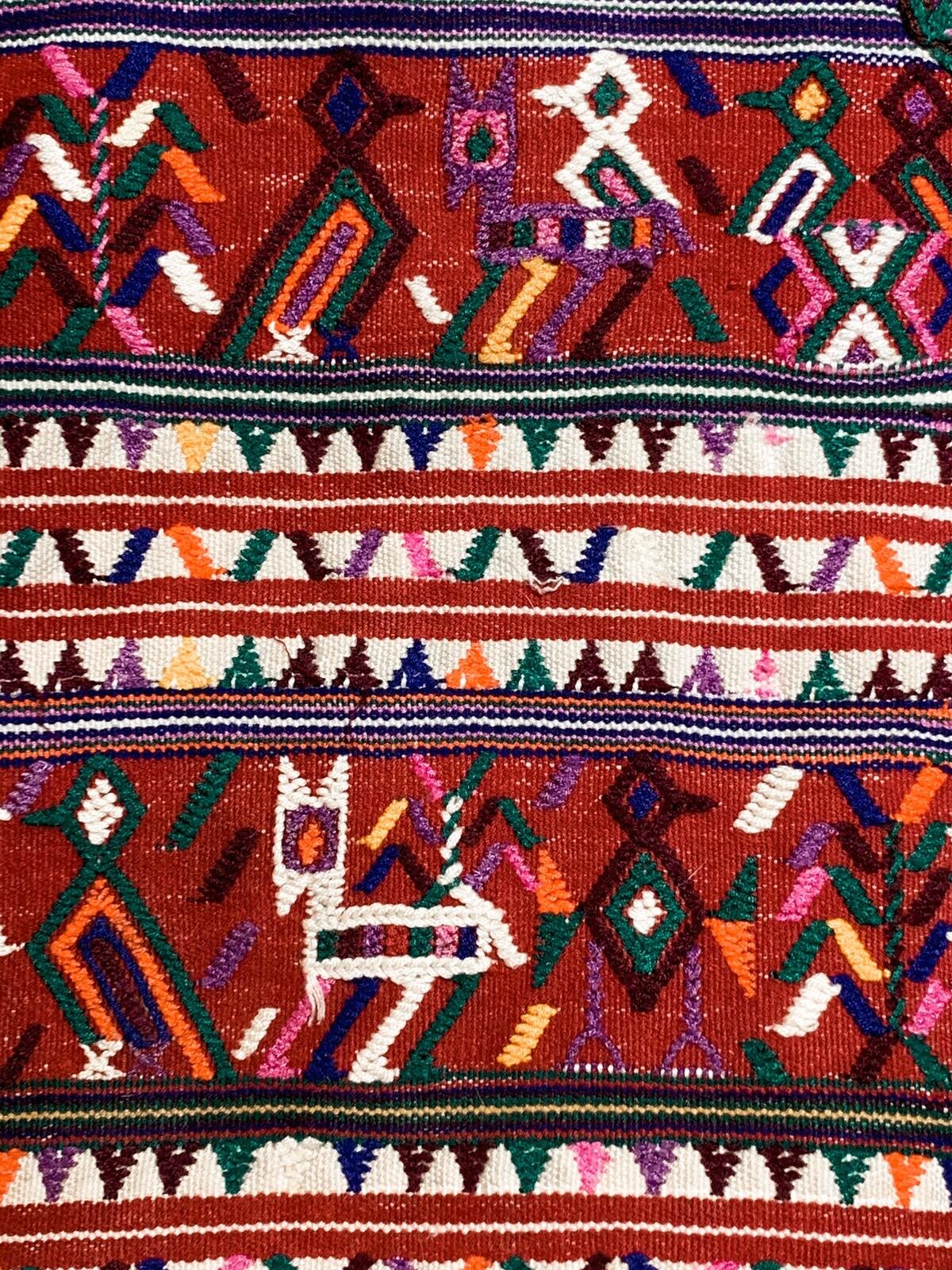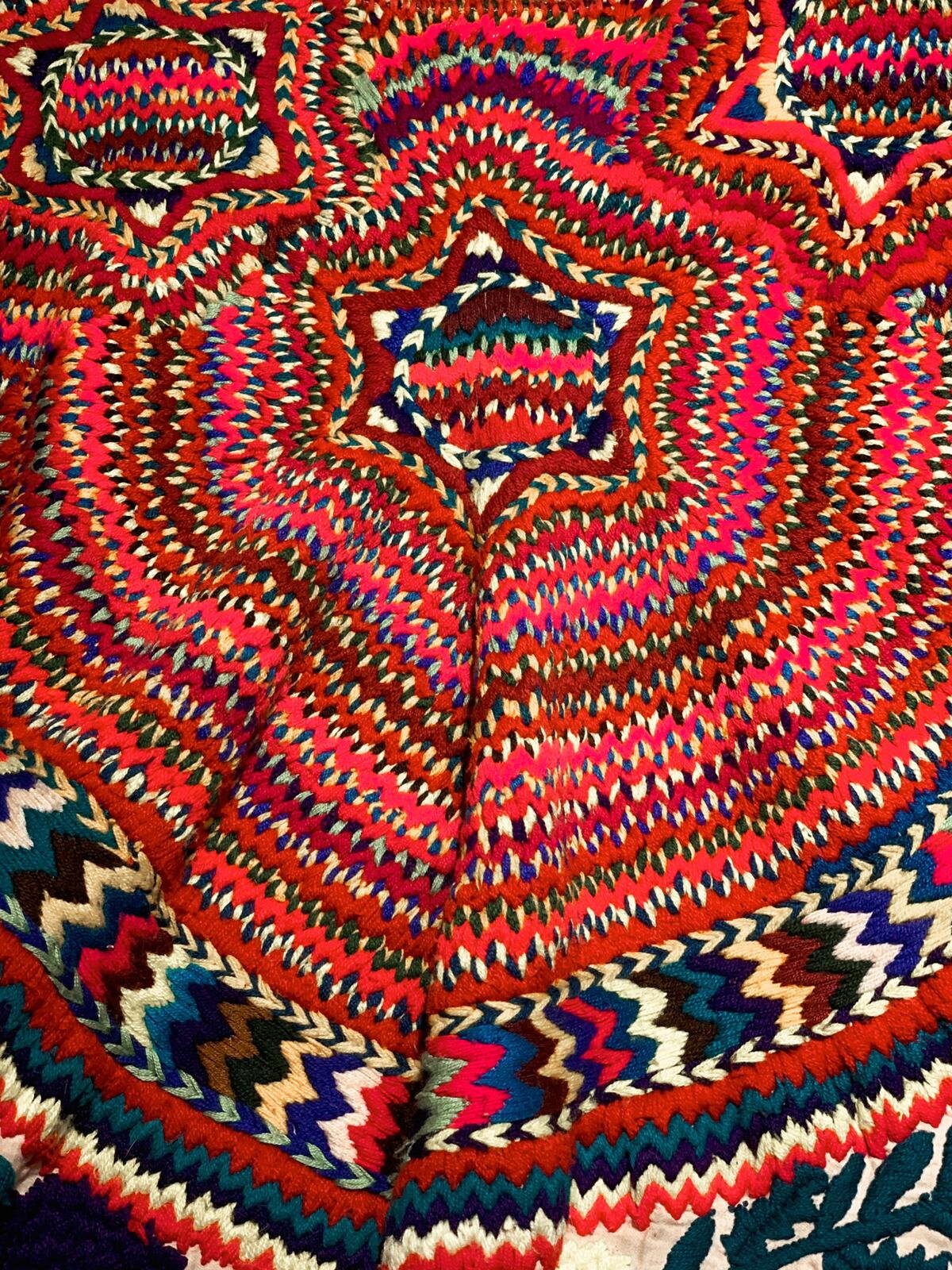The Huipil: An everlasting, indigenous cultural emblem
By: Mimi Urizar Avila
All photographs taken by Nicholas and Miriam Rittmeyer. Photographs are of weavers in Chimaltenango, Guatemala and huipiles from a private collection in Savannah, Georgia, USA.
When encountering textiles from Latin America, some of the first things we notice are their bright hues and intricate designs. The indigenous cultures of Latin America have created the complex and skillful culture and traditions that bring about the weaving of marvelous, labor-intensive textiles. Not only are these weavings visual representations of indigenous culture but also of its perseverance in the face of suppression in the colonized Americas.
In Guatemala specifically, of the most time consuming and rich textile traditions is the huipil. The huipil, or the top/torso portion of the traje (traditional indigenous womens’ dress), is worn by the Mayan people of Guatemala as an expression of ethnic identity. These stunning handcrafted garments represent a rich pre-colonial legacy of craftsmanship, visual history, symbology and storybuilding.
History
The word huipil is derived from the Náhuatl word huipilli, meaning “my covering.” Among some Mayan indigenous languages, it is known as “po´t.” In pre-colonial Central America, well into 500 C.E., huipiles were used especially in ceremonial contexts, either socially or religiously. After this period, according to archeological findings, huipiles became more commonplace among all aspects of societal life and were worn in day-to-day settings by people of varying social status.
Weaving and Women
The notion that the birth of children is tied to the symbolic birth of woven garments such as huipiles connects the identity of indigenous women into the traditionally feminine role of a weaver. Traditionally, the art of weaving has been one passed down through generations matrilineally, to young girls and women. Many women learn the craft very young, before the age of ten, and weave for the rest of their lives. Lately, with the increased schooling of young women, the time-consuming art of weaving has been difficult to pass on, yet weavers make their best effort to continue the heritage of weaving and woven visual narrative.
Composition
Materials
Traditionally huipiles were made from cotton and henequen (agave) fibers—cochineal, seashells, indigo from certain tree barks, and coffee were used as dyes to make colored thread. After the Spanish colonial invasion, materials like silk and wool were also introduced and incorporated in weaving materials. Currently, the use of synthetic fibers such as rayon, mercerized cotton thread, acrylic fiber and embroidery floss are more common and popular. Artisanal thread dying is usually reserved to the multi-color, marbled thread used in only a small amount of specific huipil designs.
Form
The huipil can be composed of one to three panels, this composition varies from department, and sometimes even from municipality and/or community. The panels are joined with special union seams, which are called randas in many areas of Guatemala. The lateral seams are left open at the height of the arm or sometimes left completely open, again this can vary by community. Sometimes lateral seams are instead joined by cords tied on each side, called tocoyales. Almost all huipiles have sleeves, some are wider than others depending on the length and number of panels. When it comes to the collar, some are created by an opening in the middle of a single panel, in between two panels, or in the middle of a third panel. The shape of each collar and how it is decorated varies by community as well, some are round, some are square, and some are very ornately embroidered while others are finished off with simple ribbons. The length of the huipil varies by community needs and local customs, especially when it comes to the weather. Some huipiles are made short, sometimes so that they are not even tucked into cortes or the skirt of the traje. Weavers from communities in consistently warmer climates, such as some in the regions of Alta Verapaz and Palín will practice making these shorter huipiles. On the other hand, weavers from communities in colder regions, like San Mateo Ixtatán, will make very long huipiles in order to help protect themselves from the cold. In San Mateo Ixtatán huipiles are made long and worn over the corte, meaning that weavers have more decoration to make for them on the longer region, some other communities wear the longer portion inside the corte and therefore leave that part undecorated.
Technique
Weavers use looms or telares to make their textiles, traditionally these were waist looms made up of thirteen different parts, most notably the mecapal or the waist strap that keeps the weaver sitting in the telar as they work. Using these looms a huipil will take about two to three months to make, if not longer. After colonial invasion, the Spanish introduced a foot pedal version of the loom that was more efficient, this loom is used nowadays but many weavers continue the tradition of waist looms, as they are not only rooted in heritage but are cheaper and easier to keep around one’s home.
In terms of decoration, there are three techniques, brocade and embroidery being the most common, along with application. Brocade has been the more traditional form of decoration used in huipiles, in which designs are built into the actual weaving of the panel, showing through both sides of the textile, while embroidery is sewn onto a completed textile.
Embroidery was introduced after colonial invasion, and was adopted by Maya weavers in Guatemala and eventually adapted by hand and with machinery. Sometimes weavers also incorporate applications of textile, beads, or other accents into huipiles.
Visual Narrative and Symbology
Huipiles are ultimately a narrative or representation using the visual vocabulary of Mayan symbology and color. Weavers carefully choose cultural motifs to convey good, evil, agriculture, fertility, personal narratives, and allude to or reconstruct mythology within the Mayan cultural and historical framework.
Some examples of common motifs/legends within huipil visual narratives are found below, these interpretations can also vary on the context of each weaver especially given the area in which they weave (department, municipality, language community):
The Sun - Often made on the neck opening of the huipil, so as to be in the center of composition, representing the centrality of the sun in agricultural life and Maya mythology.
Moon - Associated with women, given that the moon’s phases align with the menstrual cycle. Also connected to fertility and birth, given that a child needs a lunar year to be born.
Stars - A recurring motif in Guatemalan weaving given how central astrology is to Maya beliefs and spirituality.
The Lion of Riches - Supposed to bring good luck as it represents the king of the jungle who is a strong nahual of goods and riches.
Serpents - Symbolize protection, the serpent is seen as a guide for humans along the path of life. Within Maya mythology, the serpent is one of the most important animals of the cosmovision from pre-colonial culture and it is highly represented in indigenous iconography. It will often be pictured as a part of the sky or the earth, since it is seen as a sacred generator of energy in the universe.
Human Figures - Often humans holding hands will be represented in textile patterns. They can be interpreted as platonic communal solidarity, but also as romantic, marital union between men and women.
Butterfly - Represents freedom and liberty, specifically the freedom with which the weaver constructs their woven visual narrative with their own personal life force.
The Two Headed Eagle - Seen mostly in huipiles from Quiché, Chichicastenango, Palín, Escuintla, Nahualá, Sololá y Chuarrancho, and Guatemala City. This mythological creature (kot or kab-awil) represents duality in its many forms. The figure can refer to seeing the future and the past, good and evil, or up to the sky and down to the earth. It is also interpreted as symbolizing a great god with dual natures. In pre-colonial times rulers would use cepters with two headed snakes, but after colonial invasion the eagle was introduced to the Mayas in Guatemala.
Zig zags - These patterns can allude to a variety of things such as mountains, volcanoes, serpents, plumed serpents, roads, or the ups and downs of life.
Diamonds - Depending on how they are organized and their visual and geographical context, diamonds can symbolize various different notions. Some include the four corners of the universe, town squares, cosmograms, plates for tamales, or the sun’s path through the sky.
Turkeys - This figure symbolizes an offering made to a bride’s family on the wedding day. Dead turkeys are distinguishable from living turkeys in weavings because the former will appear with its neck bent backwards, whereas the latter’s neck faces forward.
Trees - In general, the tree was a primordial symbol within the Maya cosmovision. Depending on their exact rendition, trees can symbolize the tree of life, nature in general, two people sharing one life, the growth of a human, and/or the growth of a family.
Various other natural figures are seen represented throughout Mayan textiles, including plants like corn (usually seen in the cross form of a milpa or corn plot), seeds that represent agriculture, and animals like the quetzal, scorpions, vultures, toads, hummingbirds, roosters, and jaguars.
Colors
Color symbolism is also very important when it comes to the composition of each and every piece, while each community determines the specific significance of each color, there are some overarching color symbolisms that can be traced across Maya indigenous communities and their history with the huipil.
Navy blue is usually used to represent the sky and water, and sometimes the great Lake Atitlan in Guatemala.
White can represent the North, air, spirituality, hope, promise, and everything that is untouchable.
Black can represent the West, along with death, sunset, night time, recovery, and war.
Red can represent the East, sunrise, daytime, energy, honey, blood, and power.
Yellow is used to represent the South, the sun, and corn.
Green symbolizes plant life, royalty, and can specifically allude to the royal Quetzal, which is the national bird of Guatemala, native to its rainforests.
Social and Cultural Significance
As one can see, the huipiles’ visual and technical intricacies do not exist solely for the purpose of aesthetics, the semiotics of their designs are deeply tied to notions of indigenous identity. The various materials, colors and motifs of the textiles made by hand over a matter of months are visual representations of both cultural and social nature. Through the painstakingly precise and lengthy craftsmanship of a weaver, the deliberate and careful composition of motifs, colors and themes within each huipil can signify the origin, gender, class, occupation and status of the wearer.
Community Representation
One of the biggest roles the huipil has played, as mentioned earlier, is in social representation, and specifically community marking. Within each of the many language groups and specific indigenous communities that inhabit Guatemala, come idiosyncrasies represented in their communities’ weavers’ work. If one has the knowledge, looking at a woman’s huipil allows one to discern which department and even which specific indigenous community she comes from. There are about 117 set variations of combined decoration methods—brocade versus hand or machine embroidery—and loom technique—waist versus pedal/foot— in huipil making among the 22 departments of Guatemala.
The identification of specific community huipiles is determined by looking at the combination of characteristics it has in terms of color palette, distribution of decoration, the motifs used, the number of panels used in the construction of the huipil, the collar type, and the length and width of these individual panels. Here are some examples of the various unique aesthetics one can recognize from certain regions in Guatemala:
In the region of Sacatepequez, in a community such as San Antonio Aguas Calientes, huipil weavers are well known for their difficult and complex style of Guatemalan weaving and brocading. In their brocade work, they use a little stick, called a marcador to execute very fine and intricate floral and bird designs in blue and green hues.
Meanwhile, in the communities of the lacandones, who live in the northern jungle near the Mexican border, community members use long, ankle length huipiles that are made with plain white fibers and usually don’t carry any decorations.
Coban’s huipiles, which are also called kembilzo pikbil, are short in length and traditionally made of very light white cotton. Their patterning includes white woven symbols such as birds and animals, while their neckline is usually square and embroidered with brightly colored flowers.
Tecpán and Mixco usually decorate their collars with simple silk or velvet ribbon.
Quetzaltenango, or Xelaju, is known for its huipiles’ color palette of red, yellow and purple, which represent their department, weavers usually include motifs of birds, flowers, and stars in the main composition of the garment and concentrate floral and animal patterns on the collar. Here huipiles are mostly composed of three panels made with a pedal/foot loom. Their huipiles are also characterized by round collars with elaborate floral designs and a medium length.
In Chimaltenango, it is common to see huipiles with big red stripes that frame the shoulders. Stripes or bars that alternate with animal symbols and multicolored loans are also characteristic. These weavers also create V-shaped collars for their huipiles and usually decorate them with black velvet piping.
In Ixtahuacán, one can see typical geometric and colorful huipiles but the area’s garments are characterized by complex silk embroidery and wide square collars.
These are just some examples of how unique each community’s visual composition can be when it comes to huipiles, these region specific aesthetics help create a strong sense of unity and pride within individual communities in Guatemala. Characteristic designs and materials allow for the wearer of huipiles to express their ethnic identity and geographic origins in a very targeted and specific way.
Changing Context
Regardless of the rich, region specific tradition that underlies huipil craftsmanship, as briefly mentioned before, there have been changes to the ways in which huipiles are made and worn. The reality is that the cost and time of weaving huipiles and the materials needed to do so has made it less and less feasible for as many people to undertake the task. It is not uncommon for indigneous women to purchase more mass-produced, machine embroidered blouses called generalizadas.
On the other hand, the “pan-maya,” trend has seen women buy huipiles not on the basis of regional design but personal taste. More and more women have bought and worn huipiles from other communities, either as a sign of their spending power or as a gesture of sisterhood, kinship, solidarity and Maya ethnic pride.
We can only hope that these new trends and forces will only bolster the survival of the huipil tradition; a centuries-old master craft from indigenous women that continues to tell countless personal and communal stories while perpetuating the pride of the Maya people.
You can own a piece of a beautiful huipil at the same time that you help a Mayan artisan.
Sources:
Alejandra, and Ricky Lopez. “Trajes Típicos De Guatemala: Origen, Historia, Significado y Más.” Conozcamos Las Culturas De Todo El Mundo, 10 July 2019, hablemosdeculturas.com/trajes-tipicos-de-guatemala/.
Chacon Faggiani , Deborah Esther. ANÁLISIS Y DESCRIPCIÓN DE TEXTILES MAYAS DE LA COLECCIÓN “OLGA ALEJOS DE MIRÓN”, PATRIMONIO CULTURAL DE LA UNIS, PARA SU CONSERVACIÓN Y EXHIBICIÓN . UNIVERSIDAD DEL ISTMO Facultad De Arquitectura y Diseño , 4 Feb. 2006, glifos.unis.edu.gt/digital/tesis/2006/15213.pdf.
de Arathoon, Bárbara Knoke. “HUELLAS PREHISPÁNICAS EN EL SIMBOLISMO DE LOS TEJIDOS MAYAS DE GUATEMALA.” FAMSI, www.famsi.org/reports/03101es/01arathoon/01arathoon.pdf.
Editor. “El Huipil En Guatemala - Mundo Chapín.” Solo Lo Mejor De Guatemala, 20 Jan. 2020, mundochapin.com/2013/05/el-huipil/16574/.
Gabriela. “Significado e Historia Del Huipil En Guatemala.” Aprende Guatemala.com, 15 Jan. 2021, aprende.guatemala.com/cultura-guatemalteca/general/significado-huipil-guatemala/?fbclid=IwAR2wU-d1XUPzgrIrUh9XhF7irjnyxzCl-WQRo_TD2vmWtkkzpLbISwbVdcs.
Huipiles De Guatemala, huipilesdeguatemala.blogspot.com/.
“Símbolos Textiles Mayas y Su Significado.” La Casa Del Algodón, casadelalgodon.com/simbolos/.
“Textiles of Guatemala: Symbolism behind the Huipil.” Casa De Los Gigantes, 11 May 2020, casadelosgigantes.com/blogs/home-decor/textiles-guatemala-symbolism-behind-huipil.
Ventura , Carol. “El Telar De Cintura De Jacaltenango, Guatemala.” Carolventura.com, www.carolventura.com/telar.html.












